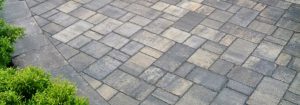
The look of concrete and pavers may be comparable, but the difference becomes clear when measuring costs, durability and maintenance.
If you have begun a landscaping project, you may now be wondering how you are going to deal with the walkway. Which is better concrete or pavers? What is the difference? What is the best situation or set-up for each? The main differences are going to be in cost, upkeep, durability and installation. Of course, the overall aesthetic will factor into the design of a garden or backyard, but it is possible order beautiful concrete or pavers. Focus first on what will work best in your budget as well as what will be most functional in your space. Things like good drainage or permanence make affect your decision making process more than a stamped design or complimentary color.
Installation for concrete slabs is quite a bit easier, but the material does take longer to set and dry. This process will include elements like evacuating the designated area and leveling it out. Then, the foundation and setting forms must be done before pouring the concrete. Be sure to pay special attention to the grading before laying anything. A shoddy job may result in major and costly repairs later. Conversely, paving stones is much more labor intensive. It includes all the preparation steps of concrete and more. However, the stones are ready for immediate use after being laid.
Concrete is also easier to maintain when compared to pavers. It can retain stains from things like motor oil, but with regular pressure washing, this will not likely be a huge issue. Plus, slabs can be coated with a protective sealant, which will prevent stains and lessen the need to pressure wash. Unfortunately, cracks may happen as the Earth naturally shifts, which may mean high long-term costs. Pavers require little care, but the stone joints and grooves must be weeded and cleaned. When the ground beneath moves, individual pavers can be reworked or replaced more easily than a concrete slab repair.
When looking at the cost differences between concrete and pavers, look holistically. Include maintenance and installation in your budget. Overtime, concrete will need to be resealed, washed and fixed when cracked. Pavers will also need weeding, cleaning and occasional replacing. Concrete firms may have a minimum size work order limitation, which can result in pavers being the cheaper alternative. However, typically pavers will be more costly because it is more labor intensive. Keep in mind that stamped concrete will likely be comparable in price to pavers and a traditional concrete slab will have greater long-term costs.
